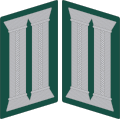Germany
Wehrmacht
In the German Wehrmacht from 1933 until 1945 there were the OF1b-ranks Assitenzarzt (physician), Assitenzapotheker (pharmacologist), and Assitenzveterinär (veterinary), comparable to the Leutnant/Second lieutenant OF1b-rank.
During wartime, the regular assignment of Assitenzarzt was the management of a battalion dressing station (de. Truppenverbandsplatz), supported by help surgeons (de: Hilfsärzte). However, a battalion dressing station could be managed by an Oberarzt (OF1a) as well.
In line to the so-called Reichsbesoldungsordnung (en: Reich's salary order), appendixes to the Salary law of the German Empire (de: Besoldungsgesetz des Deutschen Reiches) of 1927 [2] (changes 1937 – 1940), the comparative ranks were as follows: C 8/C 9
- Oberleutnant, Leutnant (Heer and Luftwaffe)
- Leutnant
- Oberleutnant zur See (Kriegsmarine)
- Leutnant zur See
- Oberarzt (medical service of the Wehrmacht)
- Assistenzarzt
- Marineoberassistenzarzt, introduced June 26, 1935 (medical service of the Kriegsmarine)
- Marineassistenzarzt
- Oberveterinär (veterinarian service of the Wehrmacht)
- Veterinär
The piping on shoulder straps shows the Waffenfarbe (en: corps- or troop-function colour), corresponding to the appropriate military service, branch, or special force. The corps colour of the Military Health System in German armed forces was traditional dark blue, and of the veterinarian service carmine red. [3] This tradition was continued by the medical service corps in Heer and Luftwaffe of the Reichswehr and Wehrmacht. However, the corps colour of the Waffen-SS HSS was cornflower blue.
| junior Rank Unterarzt Feldunterarzt (from 1940) | German medical officer rank Assitenzarzt | senior Rank Oberarzt |
Address
The manner of formal addressing of military surgeons/dentists with the rank Assitenzarzt was, "Herr Assitenzarzt"; with the rank "Marineassistenzarzt" - "Herr Marineassisgtenzarzt".
| Ranks Wehrmacht until 1945 [4] | Ranks | |||
|---|---|---|---|---|
| Medical service | en translation | Equivalent Heer | en equivalent | |
| Generaloberstabsarzt | Senior Staff-Surgeon General | General der Waffengattung | three star rank | OF-8 |
| Generalstabsarzt | Staff-Surgeon General | Generalleutnant | two star rank | OF-7 |
| Generalarzt | Surgeon General | Generalmajor | one star rank | OF-6 |
| Oberstarzt | Colonel (Dr.) | Oberst | Colonel | OF-5 |
| Oberfeldarzt | Lieutenant colonel (Dr.) | Oberstleutnant | Lieutenant colonel | OF-4 |
| Oberstabsarzt | Major (Dr.) | Major | OF-3 | |
| Stabsarzt | Captain (Dr.) | Hauptmann | Captain (army) | OF-2 |
| Oberarzt | First lieutenant (Dr.) | Oberleutnant | First lieutenant | OF-1a |
| Assistenzarzt | Second lieutenant (Dr.) | Leutnant | Second lieutenant | OF-1b |
| Unterarzt | Sergeant 1st Class (Dr.) | Fahnenjunker-Oberfeldwebel | Officer Aspirant | OR-7 [5] |
| Feldunterarzt (from 1940) | ||||
| Ranks Kriegsmarine (medical service) | Ranks | |||
|---|---|---|---|---|
| Medical service | en translation | Equivalent Kriegsmarine | en equivalent | |
| Admiraloberstabsarzt | Surgeon general | Admiral (Germany) | three star rank | OF-8 |
| Admiralstabsarzt | Rear admiral upper half (Dr.) | Vizeadmiral | two star rank | OF-7 |
| Admiralarzt | Rear admiral lower half (Dr.) | Konteradmiral | one star rank | OF-6 |
| Flottenarzt | Captain naval (Dr.) | Kapitän zur See | Captain (naval) | OF-5 |
| Geschwaderarzt | Commander (Dr.) | Fregattenkapitän | Commander | OF-4 |
| Marineoberstabsarzt | Lieutenant commander (Dr.) | Korvettenkapitän | Lieutenant commander | OF-3 |
| Marinestabsarzt | Lieutenant naval (Dr.) | Kapitänleutnant | Lieutenant (naval) | OF-2 |
| Marineoberarzt | Lieutenant junior grade (Dr.) | Oberleutnant zur See | Lieutenant (junior grade) | OF-1a |
| Marineassistnezarzt | Ensign (Dr.) | Leutnant zur See | Ensign | OF-1b |

